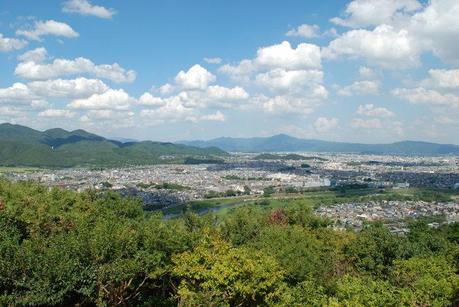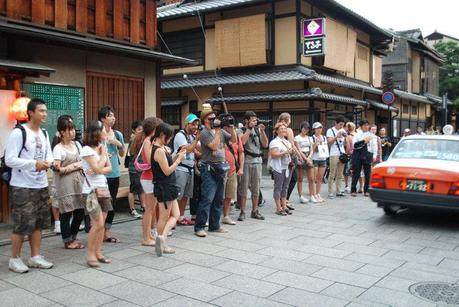 Kyoto is the quintessential Japanese city in my mind. It is large enough that it has a bigger city feel in some places, yet small enough that you can walk it if you are looking for a full day. Not only that, there are numerous aspects of Japanese culture that can be found lurking in various corners of the city. Want a monkey park? Check the outskirts of town right near the Bamboo forest. Want to find amazing temples? Go to Ryoanji Temple or Kinkakuji Temple. Want to find a geisha? Go to the Gion District.
Kyoto is the quintessential Japanese city in my mind. It is large enough that it has a bigger city feel in some places, yet small enough that you can walk it if you are looking for a full day. Not only that, there are numerous aspects of Japanese culture that can be found lurking in various corners of the city. Want a monkey park? Check the outskirts of town right near the Bamboo forest. Want to find amazing temples? Go to Ryoanji Temple or Kinkakuji Temple. Want to find a geisha? Go to the Gion District.But in a city that has has many of the major Japanese highlights in such a small area, there is a downside. The crowds. This is especially evident for those on the hunt for a geisha in the Gion District as you will never be the only one who has the thought of exploring the neighborhood in hopes of catching a photo of this elusive Japanese profession. The crowds for this sight can be so large, in fact, that I gave up in my hunt for a geisha and instead began to hunt the other travelers who were searching for the elusive photo. The hunt for the geisha hunters begins.
What Do Geishas Do Anyway?
 There is a lot of misunderstanding about geishas and what they do to earn money in the restaurants and private venues of the city. Many visitors are still under the misconception that geishas are a type of prostitute, but this is not the case. It is true that in the early 1900s many prostitutes dressed up as geishas, but they only did so to imitate the style for their clients as a means to earn more money. True geishas, especially now in modern times with prostitution being illegal, are traditional artists. Ironically, the translation of geisha truly means artist so this description is doubly appropriate.
There is a lot of misunderstanding about geishas and what they do to earn money in the restaurants and private venues of the city. Many visitors are still under the misconception that geishas are a type of prostitute, but this is not the case. It is true that in the early 1900s many prostitutes dressed up as geishas, but they only did so to imitate the style for their clients as a means to earn more money. True geishas, especially now in modern times with prostitution being illegal, are traditional artists. Ironically, the translation of geisha truly means artist so this description is doubly appropriate.Typically speaking, geishas perform several functions when hired at private venues and restaurants depending on what their clients are interested in. They may sing, play traditional instruments, dance, pour tea and other drinks, or just spend time with their clients while dressed up in the style we are all familiar with. Of course, most foreign visitors aren't going to the Gion District to actually take in one of these performances, and instead try to seek out a geisha as they make their way between restaurants in the narrow streets of the neighborhood. (Photo "Geisha" by Fergus Randall)
Hunting the Hunters
During my quest to find a geisha, while slowly being converted to hunting the hunter, I met a woman who told me she flew to Japan specifically to come to Kyoto and find a geisha. Yes, that was the purpose of her whole trip. In between being jealous in finding out that her son is a pilot and she jet sets around the world on standby tickets for these unusual tasks and pondering her statement, I realized I was in the Gion District for all the wrong reasons. While I did go to find a geisha myself, I left being more amazed by the crowds of people just like me who gathered to get a quick peak as well. We all truly had the same idea.
I can't help but think that the crowds of visitors hunting these elusive performers for a quick photo is somewhat demeaning to the art. With more people in the streets looking for a free glimpse rather than inside the restaurant as a paying customer, there is little question in my mind as to why the number of women looking to become geishas has dropped so much in recent decades. More and more gawkers, less paying customers; and before I knew it, I was one of them.
Why Are Geisha Performers Diminishing So Fast?
When doing a bit of background research for this article, I found an alarming fact. The ranking numbers of practicing geishas has dropped over 90% in the last century, with estimates point to only a few thousand performers practicing today. The overwhelming reason that has been postulated for this decline is due to a lack of interest in traditional artistry and relatively high cost for such a performance, but I think there are other factors contributing.
To look at this decline a different way, consider the geisha hunters constantly pursuing with cameras as the geishas walk from appointment to appointment. These large crowds must certainly contribute to the fact that the women who perform are almost always hidden from public eye. Rather, it is just a quick appearance outside between performances which adds to their rarity in the district and further propagates visitors quests for a photo. The less they are out in the streets, the more intrigue builds up on the profession. The more intrigue builds up, the more visitors will come to take photos rather than wanting to pay for a performance. At some point, if this trend continues to get larger and larger, this will be an added factor into the decline of the geisha art.
While I saw a few geishas in Kyoto, I gave up on trying to get a good photo. Part due to the difficulty of getting a clean shot, and part out of respect from the onslaught of photos these women were having taken of them. Instead, I enjoyed watching the hunters. Perched outside a restaurant, waiting like paparazzi for their subject to come out for another chance at the elusive photo.

The hunters are a crazy bunch, and now I truly wish I had enough money to take in a performance to give the art the respect it deserves.
Next time Kyoto. Next time.

